
Domestic Oil Tanks
Domestic Oil Tanks
Domestic fuel oil tanks in Nova Scotia are to be installed in accordance with the latest recognized edition of the Canadian Standards Association's CSA B-139, "Installation Code for Oil Burning Equipment" and the latest edition of the "National Fire Code of Canada".
In Nova Scotia these codes are regulated by the Fuel Safety Section of Labour and Advanced Education. Any questions on these codes can be directed to Paul Fowler, Chief Inspector, Fuel Safety, 424-8017 or paul.fowler@novascotia.ca
Do-it yourself installations are discouraged due to potential damage to the environment, and consequential high costs of cleanup associated with any spill. In fact, many manufacturers now require for warranty purposes that oil tank systems are installed by trained installers.
Oil / Petroleum Spills
For information on what you need to do if you have an oil spill please see Petroleum Spills.
Tank Accessories
There are a number of companies that produce products designed to protect and maintain domestic oil tank systems. The following section explains what these accessories are used for. For additional information regarding domestic fuel oil tank accessories, contact the tank supply companies (which can be located in the Yellow Pages under tanks or heating), fuel oil supply companies, or your appliance service provider.
Note: The Province of Nova Scotia does not endorse any product or manufacturer. In no event will the Province of Nova Scotia be held liable for damages, including loss of profits or consequential damages arising from information provided or accessed from this site
Oil Level Gauge Protectors
 These devices protect the fragile glass or plastic covered oil level gauge from damage. Commercial grade level gauges usually already have this safety feature incorporated in their design.
These devices protect the fragile glass or plastic covered oil level gauge from damage. Commercial grade level gauges usually already have this safety feature incorporated in their design.
Valve Protectors
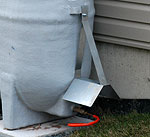 These devices protect the shut-off valve and associated product line fittings from damage.
These devices protect the shut-off valve and associated product line fittings from damage.
Release Barriers (Drip Pans)
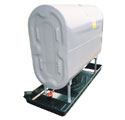 These devices catch any indoor leaks or drips. They can be installed with an audible alarm or monitored through a home security system. The alarm will alert home owners to a problem and give them time to react.
These devices catch any indoor leaks or drips. They can be installed with an audible alarm or monitored through a home security system. The alarm will alert home owners to a problem and give them time to react.
Secondary Containment Devices
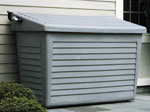 These devices are designed to hold 110% of the oil tank capacity in the event of a spill. They can be placed either outside or inside of a building.
These devices are designed to hold 110% of the oil tank capacity in the event of a spill. They can be placed either outside or inside of a building.
Anti-corrosion Devices
 These devices act as a sacrificial anode. In theory the anode will corrode first before the steel in the tank. This is similar to technology used in water heaters and boat hulls.
These devices act as a sacrificial anode. In theory the anode will corrode first before the steel in the tank. This is similar to technology used in water heaters and boat hulls.
Additives
 There are a number of these types of products on the market. They are designed to either reduce water/sludges in the tank and/or kill bacteria. However, they should be used with caution as improper use may affect system integrity.
There are a number of these types of products on the market. They are designed to either reduce water/sludges in the tank and/or kill bacteria. However, they should be used with caution as improper use may affect system integrity.
Key Components
A domestic tank system isn't just limited to the tank. It also includes a variety of mechanical components that are essential for a tank system to operate properly and safely. This section provides an overview of what all the key components of a system involves and what each component is designed to do.
Oil Level Tank Gauges
 This device is designed to indicate the level of fuel in a tank at any given time. Oil level gauges typically have a levered arm that extends into the tank The arm has a cork float on the end which rides on the surface of the oil which in turn causes the visible gauge level marker to move. The gauge has a glass or plastic covered viewing area at the top which is susceptible to damage if not protected.
This device is designed to indicate the level of fuel in a tank at any given time. Oil level gauges typically have a levered arm that extends into the tank The arm has a cork float on the end which rides on the surface of the oil which in turn causes the visible gauge level marker to move. The gauge has a glass or plastic covered viewing area at the top which is susceptible to damage if not protected.
Vent Whistles
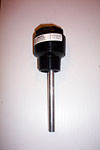 This device is designed to provide a warning to the person filling the tank that the fuel level is approaching the top of the tank. The warning is in the form of a whistling sound that can be heard during filling which increases in pitch and then stops as the oil rises to the top of the tank. Usually located at top of tank at the base of vent pipe.
This device is designed to provide a warning to the person filling the tank that the fuel level is approaching the top of the tank. The warning is in the form of a whistling sound that can be heard during filling which increases in pitch and then stops as the oil rises to the top of the tank. Usually located at top of tank at the base of vent pipe.
Shut-Off Valve
 This device is designed to allow a person to manually shut off the flow of oil from the tank.
This device is designed to allow a person to manually shut off the flow of oil from the tank.
Product Supply Line
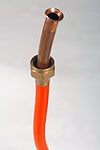 Copper product lines are the most common type of product supply line although other types are available. A common type used in industry today comes with a polyethylene coating. In the event of a line failure, the coating features special grooves that assist in containment and leak detection. Typically either 1/2" or 3/8" diameter.
Copper product lines are the most common type of product supply line although other types are available. A common type used in industry today comes with a polyethylene coating. In the event of a line failure, the coating features special grooves that assist in containment and leak detection. Typically either 1/2" or 3/8" diameter.
Furnace Filters
 These devices are designed to filter and trap contaminants and/or water before they reach the oil burner. These devices must be checked and cleaned on a regular basis. Filters are available for various particle sizes - course, fine. Some are specifically designed to capture water entrained in the oil.
These devices are designed to filter and trap contaminants and/or water before they reach the oil burner. These devices must be checked and cleaned on a regular basis. Filters are available for various particle sizes - course, fine. Some are specifically designed to capture water entrained in the oil.
Firematic Valve (Fusible Link)
 This valve is designed to automatically close oil supply lines in case of fire. It includes a spring and replaceable fusible element which melts at 78.3 °C (165°F) allowing the valve to close tightly.
This valve is designed to automatically close oil supply lines in case of fire. It includes a spring and replaceable fusible element which melts at 78.3 °C (165°F) allowing the valve to close tightly.
Oil Safety Valve (Fuel Safety Valve) / Anti-siphon valve
 These valves are designed to automatically shut-off the flow of oil from a tank in case the line between the valve and the burner is broken. This prevents fuel from siphoning out of the tank.
These valves are designed to automatically shut-off the flow of oil from a tank in case the line between the valve and the burner is broken. This prevents fuel from siphoning out of the tank.
Tank installations
Do-it yourself installations are discouraged due to potential damage to the environment, and consequential high costs of cleanup associated with any spill. In fact, many manufacturers now require for warranty purposes that oil tank systems are installed by trained installers.
The installation of the tank should be performed by a trained and licensed Oil Burner Technician
Taking care of your tank
It is important for homeowners to understand that maintaining the oil tank is their responsibility. Tank owners should treat the tank no different than if it was a car - take preventative measures. Here are some basic maintenance principles:
- Do not install a used or "refurbished" tank. Any tank that was removed from its original location was removed for a reason. Often the "refurbished" tank was either leaking at another site or was replaced due to its age. Reuse is simply inviting problems and a likely leak.
- Determine if your tank has any metal tags or labels attached. These tags will help identify whether the tank was manufactured to national construction standards. Other useful information you may find on the tag includes the year it was manufactured and, in the case of steel tanks, the gauge (or thickness) of steel used to build the tank. Note: Don't paint over the tag!
- From time to time, check the outside of your tank for any rust. Be careful when rubbing your hand over damp spots or rust bubbles. The slightest pressure may cause a small leak in a corroded tank.
- Check your tank for obvious signs of damage. Damage includes, but is not limited to, dents, bent or pinched lines, cross-threaded fittings, a broken or cracked fill gauge, cracked or weeping weld seams, and broken or heaved base support. Such damage may accelerate internal or external corrosion, oil supply line failure, threaded joint or weld failure, and/or tank upset.
- Before and after each fill, inspect the vent and fill pipes and the tank bottom for leaks and spills, as they may not be evident until a change in volume occurs.
- Remove vegetation and debris such as tall grass, leaves, ice, snow, and insect nests from on or under your tank. Any contact of this material and your tank may accelerate corrosion.
- If frost heaving or ground settling causes your tank to move, have the tank levelled immediately. A tank resting on a non-level surface may be more susceptible to upset.
- Arrange to have sludge and water removed from the tank every year. If left unchecked, water and sludge will accelerate internal corrosion in unprotected steel tanks (i.e., tanks not constructed or lined with non-corrosive materials). Also, check with your fuel company about fuel oil additives to reduce the water in your tank.
- Keep the tank relatively full over the summer so that less water from condensation will collect inside.
- Arrange to have your oil filter(s) serviced at least once a year.
- When replacing your tank, avoid transferring the contents of the old tank into the new one. New steel tanks are initially more susceptible to corrosion caused by the presence of sludge, acids, microorganisms, and water. Putting these contaminants in a new steel tank can result in premature failure in as little as eight months.
- Many oil providers now offer maintenance packages for homeowners as part of an overall customer service plan. If tank inspections are covered under the plan, potential problems may be identified early.
- A number of devices to help you detect and contain leaks are now available. These products can prevent leaks from making it into the environment by either alerting the homeowner during the initial stages of a leak or containing any spilled product.
- Nova Scotia experiences variable adverse weather and weather-related conditions, including ice storms, blizzards, hurricanes, and floods. Several weather protection devices are now available to help protect against weather-related damage. They include fill gauge and oil supply line protectors and tank stability brackets and straps.
Disposal of Old Tanks
Once a domestic heating oil tank is removed from service, both the tank and any remaining oil, sludge or residue must be removed and disposed in an environmentally acceptable manner. Do not abandon old tanks or their contents or allow oil sludge or residue to leak into the environment. It is illegal and irresponsible.
If the tank must be moved before the contents are removed, all openings should be properly sealed to prevent spills.
Your oil tank installer may be able to remove and dispose of any oil, sludge and residue left in the old tank. If not, many municipally operated households hazardous waste facilities will accept old heating oil and sludge from homeowners free of charge.
Old steel can be recycled into new products. Many metal recycling facilities, local scrap or salvage yards, and municipal disposal facilities accept old oil tanks. Ask your tank installer if he or she will take back the old tank as part of the contract to install the new tank. If not, your installer or local municipality may help you find a proper disposal location.
Top
Frequently Asked Questions
What is the largest cause of tank failures?
The leading cause for oil tank failure is corrosion which accounts for approximately 35 to 45% of tank failures reported to the department over the last several years.
What's the difference between a 12 gauge and 14-gauge steel tank? Isn't a 14-gauge tank thicker?
No, a 14-gauge tank is thinner than a 12-gauge tank. Gauge is the unit of measurement used when measuring steel thickness and a lower number means a thicker steel. However, manufacturers are now required to indicate the thickness of a steel tank in millimeters instead of a gauge value on their label in accordance with the latest edition of the Canadian Standards Association National Construction Standard for Aboveground Steel Tanks (CAN/ULC-S602-03).
I bought an old house that has fill and vent piping that exits the wall of the house. The thing is that the tank was removed years ago and both pipes are no longer connected to anything. Is this something I should be concerned about?
There have been several instances in the past where fuel deliveries have been made in error to fill pipes that were no longer connected to a tank resulting in a costly cleanup. The best course of action to take is to either permanently seal and label the fill and vent pipes as being abandoned or have them removed.
My tank always appears wet around the outlet piping but I don't see any oil spots on the floor. Is this something to be concerned about?
Yes, this is a sign that the tank is "weeping". You should have a service professional take a look at your tank as soon as possible before the "weep" turn into a costly leak.
Who do I contact if I have more questions?
More information can be obtained at the website of the Fuel Safety section of Labour and Advanced Education.
Top